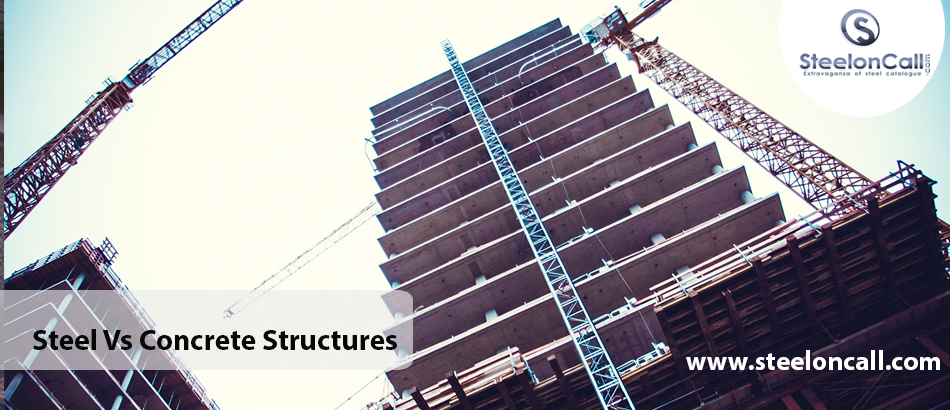Steel Vs Concrete Structures

In the building of any project, steel and concrete structures are commonly used. Steel and concrete (composite) constructions can also help save money. The decision for the usage of particular structure out of the three depends on the nature of the application of structure, cost, time duration, availability of required input material etc.
The various factors which decides the type of structure are as follows:
1) COST:
- Steel: A large majority of all steel fabricated today originates from reused materials; A992 steel. This reusing utilization makes the material a lot less expensive when compared with prime materials. The reuse of steel material is also friendly environmentally. Although the prices of various steels vary, it is affordable because of its application suitable to the particular usage.
- Concrete: An enormous money saving advantage to concrete is the way that its value remains generally reliable. On the other hand, concrete additionally requires progressing support and fixes, which means included costs all through its lifetime. Supply-and-demand may likewise affect the accessibility of concrete. Even though it can be poured and worked with directly onsite, the process of construction is a complex one.
- Steel: Steel is a flexible material that can be manufactured into a wide array of structures for unlimited applications. The strength-to-weight ratio of steel is very high when compared to other moderate structural materials. Steel additionally offers various aesthetic options that different materials, for example, concrete, can't contend with.
- Concrete: Although concrete can be formed into a wide range of shapes, it faces a few limitations with regards to floor-to-floor construction heights and long, open ranges etc.
- Steel: Structural steel is very solid, hardened, extreme, and flexible; making it one of the main materials utilized in commercial and industrial building construction.
- Concrete: Concrete is a composite material comprising of binding material (Cement), sand, stone chips and water. It has a generally high compressive quality, however needs elasticity. To boost a structure's tensile capacity, flexibility, and versatility, it must be reinforced with steel rebar.
- Steel: Steel availability has been the subject of more than a few discussions recently, with the blame placed on the consistently extending construction activity in Asian countries like China, India etc. However, specialists from the steel business are anxious to disperse the fantasy that there just isn't sufficient steel to go around. And any type of brand materials that are available in India can get from steeloncall.com with the best prices in the market.
- Concrete: Many states were reporting a shortage of cement, the primary binding ingredient utilized in concrete. The hurricanes in Florida and atypical levels of winter construction action brought about more prominent interest and short supply.
- Steel: 85% of steel is reused, a procedure made simpler by the way that magnets are utilized in the process to sort steel. New steel produced from scrapped steel utilizes around 33% of the energy necessary to produce virgin steel. Steel fabrication works to be carried out as possible as near to the site to save on transportation cost and ease to move structure to the erection location of the site.
- Concrete: Concrete is a material that is frequently locally sourced and in this manner it requires minimal energy to transport to building areas. Rebar for concrete is regularly delivered from reused steel. At the end of life, concrete can be crushed and reused as filler material etc. but not for concreting.
- Steel: Steel once exposed to air moisture/water it color changes and subsequently exposed to longer duration it will corrode. If not properly cared for, the structure's safety and security are jeopardised. To prevent steel corrosion, it is always preferable to apply a protective coating. Once proper care is taken, the life of steel is more than the life of concrete.
- Concrete: With proper construction and care, reinforced concrete is water-resistant and doesn't corrode. Proper care should be taken to avoid voids in concrete, so that the life of concrete will be increased.
- Steel: Steel has the highest strength to weight ratio of any construction material available in our daily life. Lower floor to floor heights can undoubtedly be made utilizing girder slab, staggered truss, and castellated beam construction. Amazingly long open spans are possible utilizing steel that would not be feasible with concrete.
- Concrete: Concrete can be formed into any shape and precast slabs can also be used where there is difficulty with cast insitu concrete. With using reinforcement with concrete the strength of concrete will increase and design scope increases to utilise the space and to reduce the dead weight of the structures.
2) VERSATILITY:
3) STRENGTH:
4) MATERIAL AVAILABILITY:
5) ENVIRONMENTAL CONSIDERATIONS:
6) WEATHERING:
7) DESIGN FLEXIBILITY:
Concrete and Steel are widely recognized construction materials even in daily life. Steel Structures Vs Concrete Structures is an endeavor to compare advantages and disadvantages of both materials from design, construction and maintenance perspective.
Steeloncall
09 Nov, 2019

